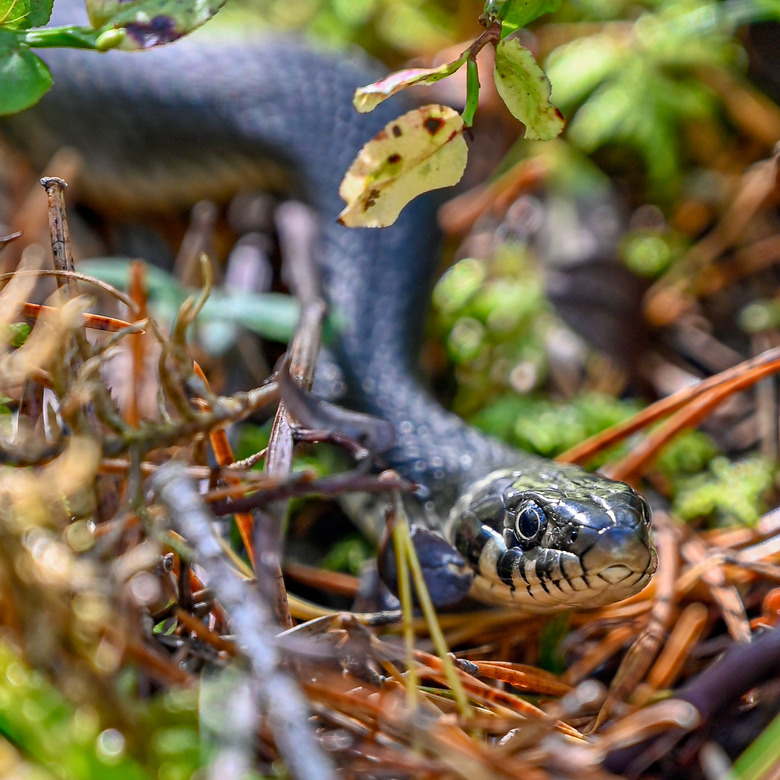Species Of Snakes In Maine
Maine is the easternmost state in the U.S. as well as one of the northernmost, forming the bulk of the land area of New England. Nicknamed "The Pine Tree State" or sometimes "Vacationland," the heavily wooded and sparsely populated area is home to an array of wildlife; although the state is perhaps best famed for its moose and deer, there is no shortage of insects, snakes and spiders in Maine.
At present, Maine is believed to include nine distinct snake species. None are venomous, so their bites are not deadly, but you should take caution when approaching them regardless because a startled animal may bite out of fear.
Common Garter Snake
Common Garter Snake
The common garter snake, Thamnophis sirtalis, is the most common of the snakes in Maine, as it is in various other places. The garter's appearance extremely variable. It lives on worms, amphibians (including fish), insects, rodents and sometimes unsuspecting birds. Its brightly colored stripes, which run along its body rather than forming rings around it, may be yellow, green and blue. It may have a grayish-blue underbelly and reach a size of 3 feet in length.
Because garter snakes can survive in a variety of habitats owing to its diverse diet, they are found in suburban and even urban areas. If you are bitten by one, this is likely to be frightening, but the bite is unlikely to break the skin.
Milk Adder Snake
Milk Adder Snake
The milk adder, or simply milk snake (Lampropeltis triangulum) is usually found in farmlands, although it is also seen in open, dry wooded areas. It is grayish-tan with brown or red-brown streaks, so it blends in readily with most soil. The milk adder eats rodents, amphibians, eggs and other snakes.
Importantly, the milk snake shakes its tail when it is afraid; between this and its appearance, these snakes are often confused with rattlesnakes (which no longer exist in Maine). Like the garter, it can reach a length of 3 feet.
Northern Water Snake
Northern Water Snake
The northern water snake (Nerodia sipedon sipedon), as its name suggests, is found in both aquatic and semi-aquatic habitats such as swamps, bogs and marshes. The "northern" in its name refers to the U.S. in general; perhaps ironically, this snake is found only in the southern half of the state. It feeds mainly on fish, as befits its living environment.
This snake does not typically become quite as large as milk adder or garter snakes, but it moves quickly and may bite more energetically than most Maine snakes if provoked. Because the scales on its skin have "keels" or ridges, its skin is not shiny, helping to keep the animal well hidden.
Red-Bellied Snake
Red-Bellied Snake
The underside of this snake (Storeiria occipitomaculata) is, unsurprisingly, reddish to orange in color. It is found in wooded areas, usually near Maine's considerable Atlantic coastline. It dines on worms, slugs and soft-bodied bugs, sufficient for this smaller snake's 1-foot (at most) length. Though not confined to the southern half of the state a la the northern water snake, its habitat does not quite extend to the northernmost portion of Maine abutting Quebec and New Brunswick. These snakes do not bite and are useful in getting slugs out of personal gardens.
Smooth Green Snake
Smooth Green Snake
Also known as the grass snake, the smooth green snake (Liochlorophis vernalis) is, owing to its color, well hidden in its habitat of meadows, gardens and lawns. If you happen across one that has recently died, the snakeskin will be bright blue. It is located chiefly in the in the south-central regions of the state. The smooth green snake favors insects in its diet, eating caterpillars, crickets, ants and grasshoppers.
Keeled Snakes
Keeled Snakes
In addition to the northern water snake described above, Maine's keeled, or scale-ridge-bearing, snakes also include four less common varieties: the northern black racer, the ring-necked snake, the ribbon snake and the brown snake. These species' diets are similar to those of its non-keel-boasting cousins, and most are relatively dull in appearance.
Cite This Article
MLA
Beck, Kevin. "Species Of Snakes In Maine" sciencing.com, https://www.sciencing.com/species-snakes-maine-8630101/. 22 November 2019.
APA
Beck, Kevin. (2019, November 22). Species Of Snakes In Maine. sciencing.com. Retrieved from https://www.sciencing.com/species-snakes-maine-8630101/
Chicago
Beck, Kevin. Species Of Snakes In Maine last modified March 24, 2022. https://www.sciencing.com/species-snakes-maine-8630101/
